Strong growth in Group turnover and PATMI was primarily driven by our Utilities and Marine Engineering businesses.
Overview
The Group achieved 25% growth in turnover to S$7.4 billion in 2005. Our Utilities and Marine Engineering businesses contributed to 72% of Group turnover. Group Profit After Tax and Minority Interest (PATMI) before exceptional items in 2005 was S$278.5 million compared to S$227.7 million in 2004, which represents 22% growth.
PATMI excluding the profit contribution from Kuehne & Nagel (KNI) and exceptional items in 2005 was 45% higher as compared to last year.
The Group recorded exceptional items of S$24.8 million for 2005. The exceptional items comprised mainly gains on disposals of associates and investments and write back of provision for loans and other recoverables. An unrealised foreign exchange loss relating to an amount accumulated in connection with the Solitaire arbitration was also recorded.
Turnover
All key businesses recorded higher turnover with Utilities and Marine Engineering contributing to 72% of the Group’s turnover.
Utilities turnover increased by 12% to S$3.3 billion. Its Singapore and UK operations continued to do well as power prices remained high, while turnover in its Offshore Engineering unit declined with the completion of some of its projects.
Marine Engineering turnover increased by 56% to S$2.1 billion. This was due to growth across all its business segments, in particular the offshore conversion and
the rig building segments. Logistics’ growth in 2005 was mainly attributed to its Supply Chain Management operations in North Asia, Southeast Asia and South Asia. Turnover for Engineering & Construction was higher as compared to last year due to the recognition of a specific project in 2005.
Turnover from overseas businesses increased by 40% to S$3.9 billion, accounting for 53% of Group turnover in 2005.
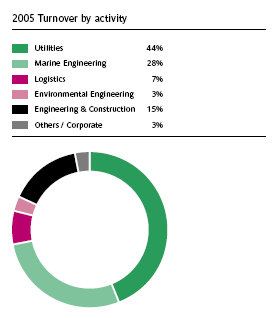
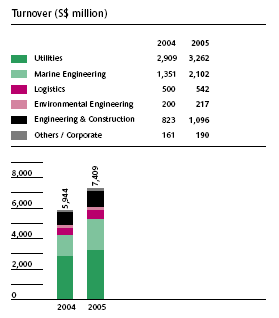 Earnings
Earnings
The Group achieved a strong growth of 22% in PATMI before exceptional items, driven mainly by our Utilities and Marine Engineering business units.
PATMI before exceptional items for Utilities increased by 36% to S$147.1 million in 2005. Strong growth continued to come from its operations in UK and joint venture in Vietnam, while its Singapore operations delivered stable performance. Losses from its Offshore Engineering unit also reduced in 2005.
The Group’s share of PATMI before exceptional items from Marine Engineering grew 22% to S$73.4 million. This was due to better overall operating profits and contribution from the associated company acquired during the year. Higher earnings in Logistics came from Supply Chain Management operations in North Asia and Southeast Asia. The weaker performance by Environmental Engineering was mainly due to the write-off of an amount due from a customer on settlement. In addition, its results were also affected by disposal costs at its construction and demolition premises, higher fuel costs and start-up costs for new overseas operations.
The Group incurred lower professional fees with respect to the Solitaire arbitration in 2005.
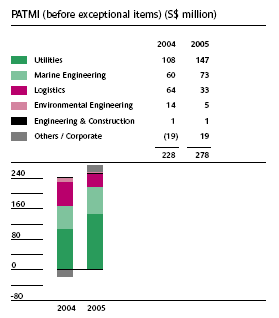
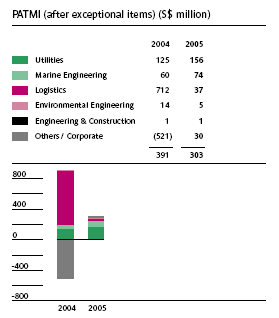
Cashflow and liquidity
As at December 31, 2005, the Group had cash and cash equivalents of S$1.2 billion as compared to S$2.1 billion as at end 2004. Cash and cash equivalents as at December 2004 included S$1.3 billion received by Logistics, for the disposal of its 20% stake in KNI. In 2005, S$702 million was paid to our shareholders and minority shareholders of Logistics via special interim dividends and capital reduction.
Our operating cashflow has been steadily growing. In 2005, cash generated from operations was S$828 million as compared to S$494 million the previous year. The increase was mainly due to better performance of our underlying businesses and better working capital management.
Cash outflow from investing activities was S$99.9 million, as compared to a cash inflow of S$1.2 billion the previous year. The cash inflow in 2004 was substantially contributed by the proceeds from the divestment of Logistics’ stake in KNI of about S$1.3 billion. Cash outflow for the addition of fixed assets was S$366 million, incurred mainly with respect to the acquisition of plant and machinery as well as capital work-in-progress for the Utilities and Marine Engineering businesses.
The repayment of loan and interest, together with the special interim dividends and capital reduction by SembCorp Industries and Logistics, led to a cash outflow from financing activities of S$1.6 billion.
Free cashflow as at December 31, 2005 was S$968 million.
Shareholder returns
Excluding the exceptional items, Return On Equity (ROE) improved from 12.8% in 2004 to 14.2% in 2005; and Earnings Per Share (EPS) increased from 12.5 cents to 15.7 cents in 2005.
However, due to lower exceptional gains from the divestment of investments, ROE and EPS after exceptional items was lower compared to the previous year.
Subject to the approval by shareholders at the next Annual General Meeting to be convened, a final dividend of 6.5 cents per share less tax has been proposed for the financial year ended December 31, 2005.
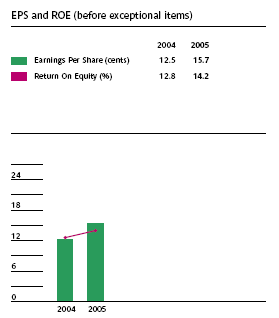

Critical accounting policies
The financial statements are prepared in accordance with the Singapore Financial Reporting Standards (FRS) including related interpretations promulgated by the Council on Corporate Disclosure and Governance (CCDG).
With effect from January 1, 2005, the Group adopted
the following new/revised FRS, which are relevant
to its operations:
| |
|
| FRS 1 (revised) |
Presentation of Financial Statements |
|
| FRS 2 (revised) |
Inventories |
|
| FRS 8 (revised) |
Accounting Policies, Changes in Accounting Estimates and Errors |
|
| FRS 10 (revised) |
Events After the Balance Sheet Date |
|
| FRS 16 (revised) |
Property, Plant and Equipment |
|
| FRS 17 (revised) |
Leases |
|
| FRS 21 (revised) |
The Effects of Changes in Foreign Exchange Rates |
|
| FRS 24 (revised) |
Related Party Disclosures |
|
| FRS 27 (revised) |
Consolidated and Separate Financial Statements |
|
| FRS 28 (revised) |
Investment in Associates |
|
| FRS 31 (revised) |
Interests in Joint Ventures |
|
| FRS 32 (revised) |
Financial Instruments:
Disclosure and Presentation |
|
| FRS 33 (revised) |
Earnings Per Share |
|
| FRS 39 |
Financial Instruments:
Recognition and Measurement |
|
| FRS 102 |
Share-based Payment |
|
| FRS 105 |
Non-current Assets Held for Sale and Discontinued Operations |
| |
|
|
In January 2006, CCDG issued FRS 21 Amendment Regulations 2006 (FRS 21 Amendment 2006). The amendment is to be applied retrospectively to financial periods beginning January 1, 2006. The Group had
adopted FRS 21 Amendment 2006 for the current financial year beginning January 1, 2005.
The effects of adopting the new/revised FRS in 2005 are set out in note 33 in the Notes to the Financial Statements.
The following are two critical accounting policies that form the basis for which the financial statements
are prepared:
Revenue recognition
Revenue on goods sold is recognised when the significant risks and rewards of ownership have been transferred to the buyer. Revenue on service work is recognised when the work is completed. Revenue from repair work, engineering, overhaul, service work and marine and civil construction contracts is recognised based on the percentage of completion method. The stage of completion is assessed by reference to surveys of work performed or by reference to percentage of costs incurred to date to the estimated total costs for each contract, with due consideration made to include only those costs that reflect works performed. Revenue on sale of electricity and gases is billed and recognised upon delivery.
Impairment of assets
The recoverability or realisable value of the Group’s assets is assessed in accordance with the various FRS. The carrying amounts of the Group’s assets are reviewed at each balance sheet date to determine whether there is any indication of impairment. If any such indication exists, the assets’ recoverable amounts are estimated. An impairment loss is recognised whenever the carrying amount of an asset or its cash-generating-unit exceeds
its recoverable amount.
Goodwill and intangible assets with indefinite useful
lives are tested for impairment annually and as and
when indicators of impairment occur.
The rest of the significant accounting policies are set
out in Note 2 in the Notes to the Financial Statements.